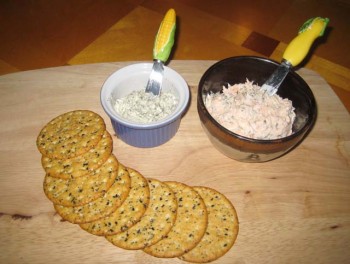
I never would have thought it was already dock (Rumex sp.) time of year again were it not for my friend Butter and the pristine metro-Denver-area suburbia full of wild green vegetables where she resides, in contrast to the still snow-covered High Country in which I dwell. But on March 7 she wrote to me: “Knock knock! Who’s there?” and then answered her own question: “Dock!”
“It was close to 70 here yesterday, which melted the last of the snow from the ground,” Butter wrote. “I took a ride today (once again in the 30’s and snowing), and surveyed the ground. The dock plants in the sunnier areas of the fields have leaves which are 1-2″ long! I estimate that in about 2 weeks, they’ll be long enough to pick the first leaves.” Oh, Front Range Denver, I sighed. It’s like the Garden of Eden.
Sure enough and earlier than predicted, Butter picked her first batch on March 14. I know because she squealed happily to Facebookland about it, announcing plans for “a nice coconut-laced dock curry.” Honestly I am more excited than jealous.
For those who do not yet know, Butterpoweredbike mans a monthly wild food recipe-sharing event and this month she’s chosen her beloved Rumex to star in it. Send in your dock recipes or post about them and send her a link to participate, or just check back at the month’s end for a wealth of cooking/foraging ideas. Even wild food greats like veteran foraging-vegetarian, Wildman Steve Brill out of NY, sometimes participate.
Dock Recipe Trials
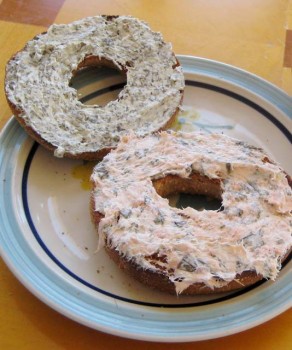
Although I myself do not have access to fresh dock right now, I am pleased to share my last year’s experiments, as well as some recent trial and error with a container of blanched, frozen dock I put away over summer.
- Dock Cream Cheese Spreads – Inspired by dad’s salmon cream cheese spread and mom’s presence, I used some finely chopped, thawed, blanched dock to make two spreads—hopping around on one foot, mind you, on account of my recent knee reconstruction. The first consisted of dock, cream cheese, a tiny bit of sour cream, and garlic. For the second I left out the garlic and added shredded wild-caught salmon. Both were well-received on both crackers and bagels, though of the two, mom and Gregg both gravitated towards the garlic dock spread. I was dubious but they insisted they were not humoring me when they helped themselves to seconds. “You’ll have to teach me to identify this one,” mom said of the lemony dock; “I like it!”
-
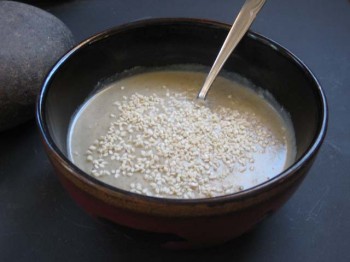
Dock Potato Tahini soup topped with sesame seeds. Potato, Dock & Tahini Soup – I was hoping the blanched dock would impart a lemony flavor to this concoction of 3 Russet potatoes, ¼ cup blanched dock, 3 cloves of garlic, 1 onion, and 2 tsp of tahini simmered together in water for a while and then blended, but it ended up not being enough dock for that so I squeezed in a hint of lemon. “I like chunky soup,” Gregg said, after I blended it. Thanks a lot, dude. The soup came out almost gray, making for an interesting presentation—especially when topped with equally light-colored sesame seeds. Gregg paused upon tasting it and said, “It’s almost bland and then you add salt and it’s great…” I’m not sure that’s a very solid endorsement. The next day I topped the leftover soup with finely ground sumac (Rhus glabra), which has a strong lemony flavor. The sumac was foraged by Butterpoweredbike and my new spice grinder does wonders getting it super fine so it’s not teeth-breakingly crunchy. It’s a nice touch and reminds me of 365 Kitchen’s yummy sumac mashed potatoes.
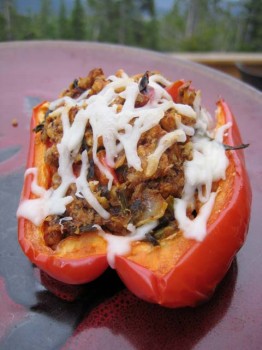
Dock and wild mushroom stuffed pepper, because I was too lazy to dig out the stuffed dock leaves photo from the old hard drive.
- Stuffed Dock Leaves and More – I’ve said it before and I’ll say it again: I like stuffing stuff with stuff. For this post, I was hoping to dig out the recipe for some dock-stuffed stuff I made last summer, but when I opened the file named “Stuffed Dock Leaves” I found only incoherent ramblings about an unrelated subject. Oh well. My general formula for making stuffing comes from dad and consists of melting butter or heating olive oil or some combination of both in a frying pan, sautéing onions and garlic until translucent, and then adding bread crumbs, liquid, and any other ingredients (wild mushrooms, chopped/cooked veggies) to make the stuffing. This is then stuffed into other stuff, such as Bell peppers, hollowed-out squash, or clamshells (don’t eat the clamshells!) and baked until the stuffing gets lightly browned and crusty. Last summer’s stuffed dock leaves most likely consisted, then, of a bread stuffing with finely chopped, sautéed fresh dock spooned onto a giant dock leaf, which was then folded to encase it, secured with a toothpick, painted with oil, and baked for 45 minutes or so at 300 or 350 degrees. These dock stuffed dock leaves were very popular with my boyfriend!
Dock Taste Test
Back when I was more of a beginner with wild edible plants, I went through a love-hate phase with docks. At first, I found only large dock leaves along a dusty road, foraged them when they were too old, and boiled forever only to create gross, slimy creations to which Gregg turned up his nose.
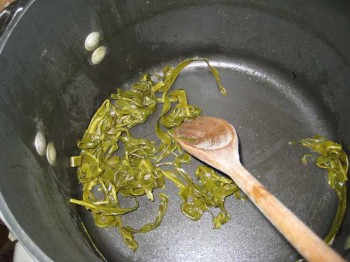
Two summers ago, frustrated with my earlier dock experiments as well some confusion over identifying different species of dock, I undertook a taste test with two varieties I eat often: one a broad-leafed species (R. occidentalis) and the other a narrow-leafed one (R. salicifolius/R. triangulivalvis). I collected relatively young specimens that time, chopping both varieties fine and then boiling in separate pots for 20-25 minutes before flavoring the mushy broad-leafed dock with butter and salt and the narrow-leafed dock with soy sauce and finely chopped raw onions.
The winner? The narrow-leafed dock by a hair, though admittedly it was poor science what with the double variable and all. Still, both were tasty enough to eat cold as leftovers for the next two days. Several authors, including the March’s in Common Edible and Medicinal Plants of Colorado (1979), and John Kallas, PhD, in Edible Wild Plants (2010) indicate a preference for curly dock (R. crispus), but I have yet to try that one.
“Just keep in mind, a well-hydrated plant that has healthy great-looking leaves is more likely to have leaves that cook into greatness,” Kallas states in his discussion of curly dock harvesting, though I imagine the same principle can be applied more broadly. He says that curly dock leaf stems and main veins are tough and stringy except in very young plants, so he recommends removing them prior to preparing, but I do eat the leaf stems of my young broad-leafed variety. Kallas also says a little bit of red spotting on the leaves is not a concern. He includes some neat recipe ideas in his book, like Curly Dock Greens with Raspberries and Cashews, and that’s just in the dock section.
Sam Thayer also includes a detailed and informative dock account in Nature’s Garden (2010).
As with all things, time and practice have rendered me much more comfortable and capable collecting and consuming docks. My current practice is to collect dock leaves young—whichever variety—and sauté them, finely chopped, in oil with onions until it the dock becomes the slightest bit fried and crispy, and then serve as a side dish or throw into stir fries or stuffings.
Get on it, Dock!
Another month or so remains before my own local docks will be ready, but based on Butter’s report, the time seems about right for those of you who dwell in parts lower, at least in Colorado. For the uninitiated, it’s a good time to be on the lookout for young docks and other edible wild plants—taking pictures, cross referencing with ID guides, and studying them as they grow. Do that and it may not be long before you develop pattern recognition for new edibles, opening up the possibility of free wild organic Rumex and other greens on your own dinner plate, in some places from spring all the way through fall.
For more ruminations on dock, particularly local Colorado High Country dock identification, please see my past entry, Reconciling Docks.

[…] Read the rest of this entry […]